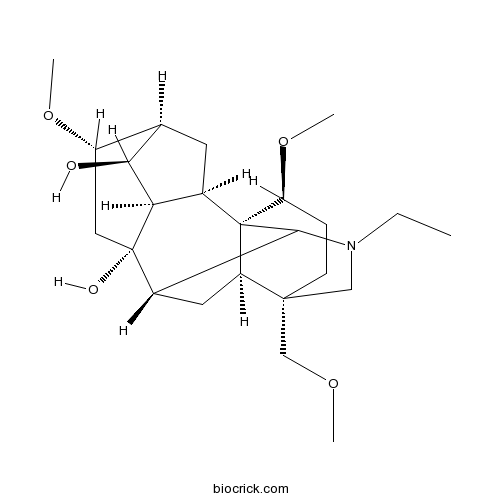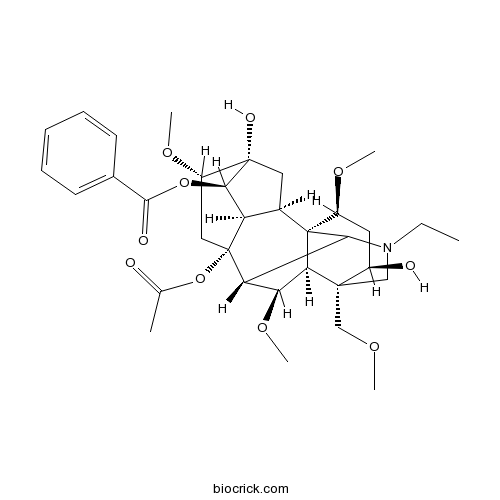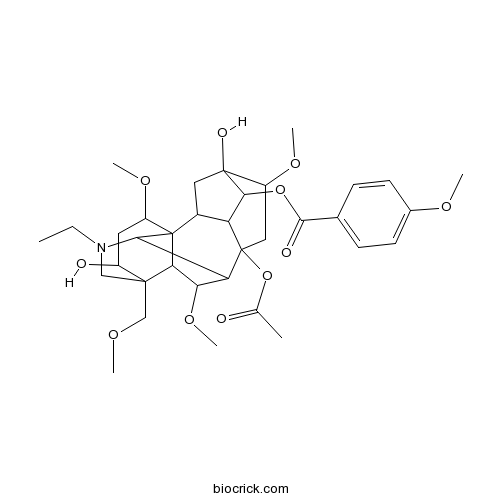Aconitum hemsleyanum
Aconitum hemsleyanum
1. The products in our compound library are selected from thousands of unique natural products; 2. It has the characteristics of diverse structure, diverse sources and wide coverage of activities; 3. Provide information on the activity of products from major journals, patents and research reports around the world, providing theoretical direction and research basis for further research and screening; 4. Free combination according to the type, source, target and disease of natural product; 5. The compound powder is placed in a covered tube and then discharged into a 10 x 10 cryostat; 6. Transport in ice pack or dry ice pack. Please store it at -20 °C as soon as possible after receiving the product, and use it as soon as possible after opening.
Natural products/compounds from Aconitum hemsleyanum
- Cat.No. Product Name CAS Number COA
-
BCN5403
Talatisamine20501-56-8
Instructions

-
BCN6259
Indaconitine4491-19-4
Instructions

-
BCN6261
Yunaconitine70578-24-4
Instructions

Structure-analgesic activity relationship studies on the C(18)- and C(19)-diterpenoid alkaloids.[Pubmed: 19652403]
For evaluation of C(18)- and C(19)-diterpenoid alkaloids as analgesics, three C(19)-diterpenoid alkaloids were isolated from the roots of Aconitum hemsleyanum var. circinatum and A. transsecutum; and twenty-five semisynthetic C(18)- or C(19)-diterpenoid alkaloids were prepared from lappaconitine, crassicauline A or yunaconitine. In a mice acetic acid-induced abdominal constriction assay, four crassicauline A analogs and three yunaconitine analogs exhibited good analgesic activities with 77.8-94.1% inhibition range in 0.1-10 mg/kg subcutaneous (s.c.) dose range at the point of 20 min after drug administration. Among them, 8-O-deacetyl-8-O-ethylcrassicauline A (ED(50)=0.0972 mg/kg) and 8-O-ethylyunaconitine (ED(50)=0.0591 mg/kg) were the most potent analgesics relative to the reference drugs lappaconitine (ED(50)=3.50 mg/kg) and crassicauline A (ED(50)=0.0480 mg/kg). Analgesic activity data of these C(18)- and C(19)-diterpenoid alkaloids indicate that a tertiary amine in ring A, an acetoxyl or an ethoxyl group at C-8, an aromatic ester at C-14, and the saturation state of the ring D are important structural features necessary to the analgesic activity of the C(19)-diterpenoid alkaloids.
C19-diterpenoid alkaloids from Aconitum hemsleyanum var. circinatum.[Pubmed: 17432903]
Seven new C19-diterpenoid alkaloids, circinasines A-G (1-7), together with six known compounds, talatisamine, yunaconitine, senbusine A, sachaconitine, hemsleyanisine, and isohemsleyanisine, were isolated from the roots of Aconitum hemsleyanum var. circinatum. The structures of 1-7 were determined by the interpretation of spectroscopic data and by the single-crystal X-ray crystallographic analysis of 6 and the acetonide derivative of 1. In addition, the structures of hemsleyanisine and isohemsleyanisine were revised from 8 and 9 to 10 and 11, respectively.
New C19-diterpenoid alkaloids from Aconitum hemsleyanum var leueanthus and Delphinium potaninii.[Pubmed: 12931854]
A new franchetine-type (leueandine 1) and two new lycoctonine-type [potanisines F (3) and G (5)] C19-diterpenoid alkaloids have been isolated from the roots of Aconitum hemsleyanum var. leueanthus and Delphinium potaninii, respectively, and their structures were established on the basis of spectral data.
Hemsleyatine, a novel C19-diterpenoid alkaloid with 8-amino group from Aconitum hemsleyanum.[Pubmed: 12736463]
The new compound hemsleyatine (1) was isolated along with four known C(19)-diterpenoid alkaloids: indaconitine (4), yunaconitine (5), chasmanine (6), and talatisamine (7) from the roots of Aconitum hemsleyanum PRITZ. Structures were established by spectral analysis, including tow dimeusional (2D) NMR spectroscopy and a chemical method. Hemsleyatine (1) is the first C(19)-diterpenoid alkaloid bearing the 8-amino group. In addition, the assignments of some (13)C signals for pseudaconine (3) were revised by comparison with those of hemsleyatine (1).
New norditerpenoid alkaloids from Aconitum hemsleyanum var. leueanthus.[Pubmed: 12608863]
Four new norditerpenoid alkaloids, leueantines A (1), B (2), C (3), and D (4), were isolated from the roots of Aconitum hemsleyanum var. leueanthus. The structures of 1-4 were established by spectroscopic evidence.
New norditerpenoid alkaloids from Aconitum hemsley anum var. pengzhouense.[Pubmed: 11249605]
Two new norditerpenoid alkaloids, 13-deoxyludaconitine (1) and 8-deacetylsungpaconitine (3), were isolated from the roots of Aconitum hemsleyanum Pritz var. pengzhouense and their structures were elucidated by spectral data.
[Botanical origins of Chinese drug caowu produced in Sichuan].[Pubmed: 2282151]
We have made an investigation on the botanical origins of 6 species and 2 varieties of the traditional Chinese drug Caowu produced in Sichuan, and found out that the main species available on the market are Aconitum hemsleyanum and A. hemsleyanum var. leucanthum, while A. legendrei comes second. A key for their identification is presented in this paper.


